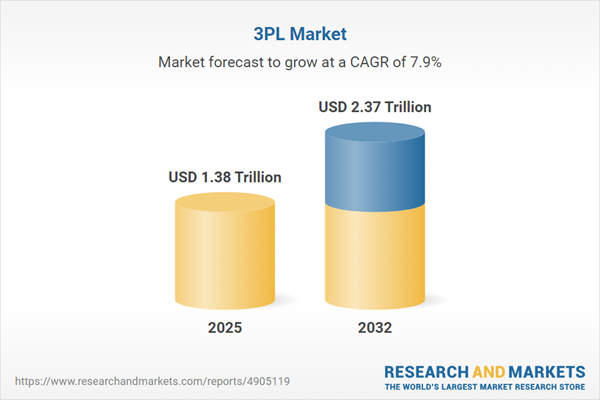Speak directly to the analyst to clarify any post sales queries you may have.
Senior leaders in the third-party logistics market face a shifting landscape marked by technological advancement, evolving regulations, and dynamic global trade patterns. Navigating these challenges calls for resilient, agile approaches that reveal new operational efficiencies and drive sustainable competitive advantage.
Market Snapshot: Third-Party Logistics Market Size and Growth
The global third-party logistics market is valued at USD 1.28 trillion in 2024, with projections rising to USD 1.38 trillion by 2025 and exceeding USD 2.37 trillion by 2032. This growth trajectory, representing a CAGR of 7.93%, is propelled by deepening digitalization, continuous supply chain automation advances, and greater adoption of collaborative models among logistics partners. Digitally enabled processes are streamlining operations, enhancing efficiency, and empowering organizations, from established players to those in emerging markets, to make agile, data-driven choices amid robust competition and ongoing market volatility.
Scope & Segmentation: Actionable Insights for Decision-Makers
This comprehensive analysis equips executives with clear segmentation and strategic focus areas to optimize business strategies within the third-party logistics market. Segment insights guide leaders toward informed investment and operational decisions, supporting scalability and resilience in logistics models.
- Service Type: Covers freight forwarding, kitting, assembly, labeling, packaging, warehousing, and distribution, highlighting their impact on optimizing inventory and adapting fulfillment to changing demand.
- Mode of Transport: Evaluates air, rail, road, and sea freight, illustrating the strategic use of multimodal networks to boost route flexibility, manage disruption risk, and implement sustainable transport initiatives aligned with environmental goals.
- Logistics Model: Considers inbound, outbound, and reverse logistics, focusing on areas such as traceability, asset recovery, and regulatory compliance—especially relevant for sectors with significant returns management or complex regulatory landscapes.
- Industry Vertical: Assesses third-party logistics solutions for automotive, electronics, food and beverage, healthcare, pharmaceuticals, and consumer goods, emphasizing compliance needs and sector-specific process specialization.
- Geographical Coverage: Examines logistics networks in the Americas, EMEA, and Asia-Pacific, offering granular insight into regional dynamics for the United States, China, India, Brazil, UK, Germany, and Japan, supporting market entry and expansion strategies.
- Key Companies: Profiles industry leaders such as CEVA Logistics, DHL International GmbH, FedEx Corporation, IPSCOM Private Limited, Kuehne + Nagel Management AG, Nippon Express, Pantos Logistics, Warehousing Express Logistics, Yusen Logistics, DSV A/S, and Dachser Group SE & Co. KG, highlighting their use of advanced technologies and scalable solutions for evolving client demands globally.
Key Takeaways for Strategic Decision-Making
- Advanced digital platforms increase transparency across all logistics stages, enabling faster, more confident executive decisions and streamlined processes.
- Integrating sustainability into logistics strategies sets organizations on a path to minimize risks from regulatory change and drive progress toward energy efficiency.
- Localized and decentralized logistics models offer enhanced supply chain continuity and rapid responsiveness during market fluctuations or sudden disruptions.
- Well-designed digital ecosystems deliver compliance support and operational flexibility, empowering organizations to adapt swiftly to shifting regulations and diverse customer requirements.
- Industries with stringent standards, such as automotive and healthcare, benefit from robust supply chain controls that underpin reliability and strict adherence to regulatory frameworks.
Tariff Impact on Costs and Supply Chain Configurations
Evolving U.S. tariff policies require organizations to re-examine cost structures and reinforce global supply chain strategies. Adoption of advanced trade management technology, diversification of sourcing, and reliance on specialized customs advisory expertise become essential levers for risk mitigation. Leveraging real-time, data-driven logistics planning allows businesses to maintain operational integrity despite fluctuating trade regulations and helps secure continuity in a changing regulatory environment.
Methodology & Data Sources
Research methodology integrates direct interviews with logistics industry executives, verified with leading industry association benchmarks. The findings draw upon advanced geospatial and forecasting tools, ensuring reliable intelligence for executive planning and supply chain risk management.
Why This Report Matters
- Equips logistics leaders with guidance for advancing digital transformation and process optimization across intricate supply networks worldwide.
- Provides actionable frameworks for designing resilient networks and making informed capital allocation decisions to support critical market operations.
- Strengthens preparedness for evolving risks, supporting robust organizational response across shifting regulatory and business climates.
Conclusion
With insights from this report, senior executives can shape flexible logistics strategies, increase organizational agility, and enhance performance in a rapidly evolving international marketplace.
Additional Product Information:
- Purchase of this report includes 1 year online access with quarterly updates.
- This report can be updated on request. Please contact our Customer Experience team using the Ask a Question widget on our website.
Table of Contents
3. Executive Summary
4. Market Overview
7. Cumulative Impact of Artificial Intelligence 2025
Companies Mentioned
The companies profiled in this 3PL market report include:- CEVA Logistics by CMA CGM Group
- DHL International GmbH by Deutsche Post AG
- FedEx Corporation
- IPSCOM Private Limited
- Kuehne + Nagel Management AG
- Nippon Express Co. Ltd.
- Pantos Logistics Canada Inc.
- Warehousing Express Logistics Pvt. Ltd.
- Yusen Logistics Co., Ltd.
- DSV A/S
- Dachser Group SE & Co. KG
Table Information
| Report Attribute | Details |
|---|---|
| No. of Pages | 181 |
| Published | November 2025 |
| Forecast Period | 2025 - 2032 |
| Estimated Market Value ( USD | $ 1.38 Trillion |
| Forecasted Market Value ( USD | $ 2.37 Trillion |
| Compound Annual Growth Rate | 7.9% |
| Regions Covered | Global |
| No. of Companies Mentioned | 12 |









